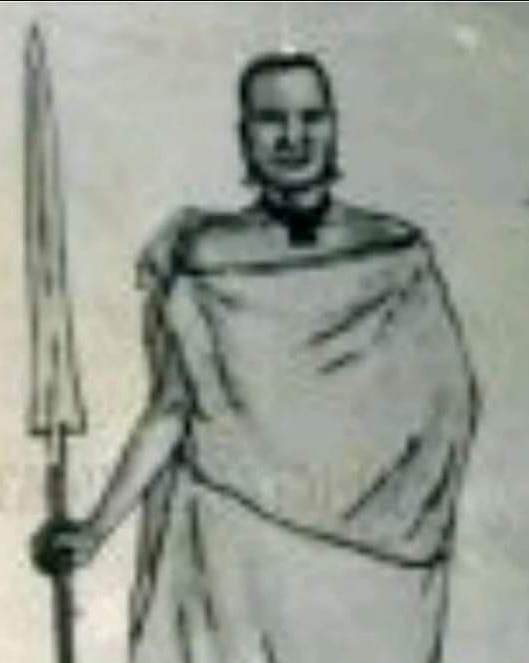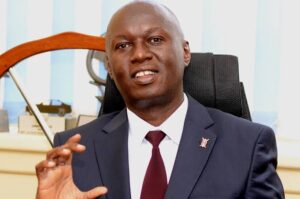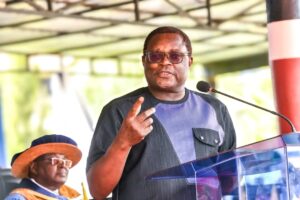Murdering An Orkyot, How Kimnyooleei Simboleei Araap Turugat Was Killed

Why did the Nandi kill a 100 year old senile old man who had brought so much wealth and military success to the community?
An Eclipse of the Sun occurred on his death in 1890, devastating social and military disasters for the Nandi followed his Execution. Some feel cleansing of the Nandi Pororiosek that Killed Kimyoleei is long overdue.
It is recorded that a solar Eclipse occurred in Western Kenya, on 17th June 1890, the year of Kimyoleei execution. Whether this is a coincidence or not is a topic for conspiracy theorists.
Here is the story of the execution of a senile, blind old man who had brought so much prosperity and mighty military conquests to the Nandi.
He was the father of Koitalel Araap Samoei, Kipchomber Araap Koilege and other prominent Orkoik of the late 1890s.
The descendants of the great Maasai Laibon-Oorgoiyoot, as well as those of the traditional indigenous Kalenjiin types, occasionally faced the peoples’ wrath when suspicious, unexplained calamities befell either the larger society or individual families; when those oorgooik failed consecutively in their prophesies; or when they failed to foresee calamities; or if they persistently predicted such calamities which either materialised subsequently, or turned out to have been hoaxes.
The most notable of the Oorgooik that were executed for whatever reason, was Kimnyoolei araap Turuugat of Nandi.
We may now narrate the sad story of Kimnyoolei whose tragic end bore enormous ramifications all over Kalenjiinland. With the benefit of hindsight, his manner of going affected the Kalenjiin nation probably as catastrophically as British colonialism itself did by coming.
Kimnyoolei araap Turuugat, the laibon-Oorgoiyoot who was executed in 1890, is remembered more for his execution than for the fact that he had come from the great House of Turuugat, his father, and for the fact that he had overseen the tremendous growth in cattle-wealth in Nandi during his earlier years on the throne. “The fourth Orkoiyot was,” writes Hollis, “however, clubbed to death by his own people.
This was done as he was held to be responsible for several public calamities. First of all came famine; this was followed by sickness; and then a raid, which the Orkoiyot had sanctioned against Kavirondo (Kavirondo meant Luo or Luhya) was so disastrous that out of 500 warriors who set out but two returned alive … ” According to Ex-chief Torongei araap Taptugen ‘s memoirs, taken down by Toweett in 1951, The Nandi executed Kimnyoolei because they suspected him of bewitching their cattle. Before the cattle began dying, the Nandi had raided cattle from the Pokoot fellow Kalenjiin.
The Pokoot cattle brought a disease called kimukusi. All of the cattle raided from the Pokoot died and were soon followed by most of the Nandi original stock-hence the general anger.
Poor King Kimnyoolei, there had erupted this deadly rinderpest cattle disease, starting from a place far out of his area of jurisdiction. The disease was all over Rift Valley and beyond, and Maasai cattle had died in even larger numbers than what was recorded of Nandi cattle. The use of ox-drawn carts by traders and colonial officers had helped spread this animal disease along the caravan route to Buganda.
But to the Nandi Kimnyoolei, who had apparently stopped them from further raiding at that time-they seem to have gone to raid Pokoot in defiance-had visited the disease upon their stock because of the disobedience.
According to Matson, the Nandi “were enraged by his failure to protect them from Natural calamities and to ensure the success of a combined raid against the Kavirondo or Suk (Pokoot). It was also possibly a manifestation of uneasiness at the Laibon’s growing authority and the encouragement his pretensions had received, at a time when conditions were especially favourable for their rapid advancement.
The tribal frontiers had been secured by the expulsion of the Arabs and the defeat of the Masai, prosperity in the form of looted cattle was enjoyed by the Nandi as never before and morale was at its peak. This happy state of affairs was attributed by some sections to the Laibon and to tribal obedience to his commands.”
The second speculative reason supplied by Matson effectively proposes that Kimnyoolei was executed out of the jealousy that was aroused by the phenomenal success of his economic policies and management. This is the line of argument that Kimnyoolei’s own descendants love to pursue, on occasion splicing, as one of the likely causes, a scenario of clashing modes of economy that competed for limited space.
Of course it was very un-Kalenjiin-like to murder someone on account of his success and it is, therefore, easily the unlikeliest of the speculations proffered so far either in the oral field or in the written works.
Kimnyoolei’s own living descendant, Kipsaang’ araap Busienei, has a version of the same event which is, naturally, a lot more sympathetic to his ancestor. The wealth in cattle which Kimnyoolei had led the Nandi in acquiring, was to be the monarch’s own undoing.
The Kaapchepkeendi pororyeet, whose immediate consultant Oorgoiyoot Kimnyoolei was, had benefited most from the cattle raiding that Kimnyoolei organised.
But their huge herds of cattle later on inconvenienced some sections of the Chesuumei county as well as the Kaptumoiis pororyeet of Nandi. These sections had not taken part in cattle raiding but had instead stuck to Mong’o’s farming methods and game hunting.
The cattle of Kaapchepkeendi often trampled on the plantations in the Chesuumei County, destroying the crops. And out in the wild, Kaapchepkeendi’s cattle fell into the elephant and buffalo pit traps that had been set up by the men of the Chesuumei County alongside the men of Kaptumoiis pororyeet.
Kaapchepkeendi were angry, so they fenced off the game pit traps, rendering them useless. Arguments followed, tempers flared and Kaapchepkeendi men beat up the men of the Chesuumei-Kaptumoiis “league”.
The Chesuumei-Kaptumoiis “league” would not take the beating lying down. So they went to address the “source” of it ali Kimnyoolei, at his Saamiytui palace, Nandi.
They gave him an ultimatum, that he use his powers to immediately restore the previous economic status quo by reversing the wealth in cattle (as held by Kaapchepkeendi and other Nandi pororyoosyek other than sections of the Chesuumei county and the Kaptumoiis pororyeet), failure to do which he should leave Nandi, or stay put and await execution.
The rigid, ageing king, by this time blind and a bit senile, could not bring himself to precipitating a magical action or a proclamation that would set in motion the reversal of the national prosperity that he had helped generate. And rather than go into exile, or go back to his original Maasai home under humiliation, he chose to be executed.
And because, ironically, he was above judicial proceedings, though not above mob injustice, or “jungle” law, his exchange with the youth ofChesuumei-Kaptumoiis “league”, had constituted a “full trial”.
Kimnyoolei was given time to talk to his sons and the maootik. His sons were Kiptoiing’eeny (Kipchomber) araap Koilegeen, Kibuiguut araap Sing’oei, Kimng’eetich araap Boiisyo, and Koitaleel araap Samoei. He informed these sons of the inevitable, and then sent for the Maootik.
Quite interestingly, Kimnyoolei had maootik all over Kalenjiinland. This can be interpreted to either mean that he had actually been the recognised leader of all the Kalenjiin people, or that some of the maootik had only amounted to mere resident ambassadors of his that served in lands which fell under the jurisdiction of other oorgooik (and kiirwoogik where the oorgooik institution did not exist).
Anyhow, apart from the Nandi-based maootik, the following were summoned and they came to Saamiytui: araap Muroon from Keiyo; araap Tapteigaat from Tugen; Mugeeni from Kipsigiis; Aneene from Terik; araap Samoiywot from Cherang’any and araap Sungula from Mt Elgon, among others.
His maootik, who were his personal representatives as well as legal advisors, pleaded with the ageing monarch to even consider shifting to the Kaapchepkeendi area where the local army, which he had benefited a great deal more, would be sure to guarantee his continued rule and dear life. But he would not hear of such “cowardly” act.
Instead, in a moment of prophetically possessed mood, Kimnyoolei produced a special tiny earthen pot of beer, a divining machine that all the oorgooik used for peering into the future. The liquid content of the divining pot reflected images of events that were yet to unfold. Kimnyoolei then passed the special pot around so that all the maootik could see the reflections for themselves.
They reported to the Oorgoiyoot the images that they had seen in the magic pot. They had seen in it certain reflections which Kimnyoolei interpreted for them as follows: what appeared like men 650 Isis and Asiis carrying sticks that spat deadly fire were white men coming with their deadly guns; what looked like smoke-puffing snakes were the railway and the trains.
These things were coming, and the earth would inevitably be rendered unworthy of continued habitation by the self-respecting people who valued freedom.
The Oorgoiyoot took the pot back from his now-perplexed maootik, then tossed it westward of him, and it broke into little bits. He was cursing as he did this. He cursed the Nandi-if they would actually kill him-to break up, after the event, like the earthen pot that he had just smashed.
This was later interpreted to have meant that under that spell, the Nandi would break up so totally they could not be mended up, because broken pots were irreparable. He also cursed the Kipsigiis.
The Kipsigiis were cursed to break up in the manner of a gourd. This was later interpreted to have meant that under the spell, the Kipsigiis would break up but unlike in the designated fate for the Nandi, their broken state would be repairable-because gourds were, unlike earthen pots, mendable.
Probably Kimnyoolei did not impress too many of his listeners with this prophesy, because this was 1890 AD and white men had criss-crossed Kalenjiin territory several times before the time of the prophesy, armed with guns, which the trading Arabs before them, had had anyway.
The latter had even demonstrated gunpowder power before some Nandi youths about thirty years or so before the prophecy. A white man, J. Thomson, had passed through Uasin Gishu seven years earlier, in 1883, on his way to Lake Victoria and returned to the coast in 1884 via Mt. Elgon and Keiyo, the latter two being parts of Kalenjiin territory in which Kimnyoolei had maootik.
The Arabs had been here, in Kipsoboi, right in the centre of Kimnyoolei’s own home turf of Nandiland, in the 1850’s and 1860’s, when they had fought Kimnyoolei’s men with guns.
The Nandi soldiers, with the blessings of the Oorgoiyoot, had won that battle hands down.
And rumours about a railway, and what it meant, must have reached Kimnyoolei and his maootik through their network of secret agents, because European survey teams were criss-crossing Rift Valley, surveying the railway route before Kimnyoolei’s tribulations had started.
So the Old Man seems to have prophesied, if indeed he ever did, what was almost common knowledge all over east Africa at the time, but some interested parties seem to have since twisted the facts to incorporate a prophesy, and a “fulfilled” one at that.
If the act of prophesy itself, and its contents, be doubtful, then doubtful also must be the claim that he at the same sitting cursed his own people in the manner narrated. Not all the Nandi sections were involved in his tribulations, in fact others were anxious to see him spared, why would he then curse all of the Nandi?
Why would he curse the Kipsigiis who were not involved in his tribulations whatsoever, and whom he was, in fact, asking-through Mugeeni-in the same sitting, to shelter all his (Kimnyoolei’s) sons ifhe should be executed?
Kimnyoolei would still be great enough without being accorded false credit, and he would certainly be better off without being, perhaps unwittingly, cast in the mould of a capricious, malicious, inconsiderate elder who would, though in desperation to save his own skin, throw curses about so needlessly.
Kimnyoolei died the death of a martyr, pure and simple. A hero wronged in his twilight years. But so persistent are the “curse” claims and most of the elderly informants in the field, feh that a form of cleansing of the Nandi people has been overdue for so long.
The killing of the Great Man alone is probably enough to justify a cleansing ceremony of a sort-of the sections that were involved in the act A continued feeling of guilt, especially among certain sections of the Nandi, that something is still amiss and will remain so until such a cleansing will have taken place, psychologically inhibits the desired proud march forward, as well as provides a ready scapegoat for everything that goes wrong in Nandi.
To continue with the story: while Kimnyoolei asked Mugeeni to take and shelter his sons in Kipsigiis, away from those that might want to murder them as well in Nandi; he instructed araap Tapteigaat, the maootyoot from Tugen, to go to Tindireet Hill and shoot down the benevolent Thunder so that rain may forthwith cease to fall. This way those who would execute the king would come to know that they had killed an innocent man.
The assembly broke up, and the brave blind Old Man “saw” everyone off. One night, not long after the big meeting, Kimnyoolei was woken up by the soldiers from the Chesuumei county and the Kaptumoiis pororyeet.
“What is it my children?” the old man asked from inside the house, “Have you come to seek permission to go on a raid?” He inquired of them, although he knew well that his time had come.
“No, Old Man”, replied the soldiers, “It is you we have come for.
Can you come out, or shall we have to burn down the house with you inside?” They demanded. The king then instructed his wife to open the door, and he groped about his way out into the dark-not that it made much difference to him, blind as he was–and into the hands of the impatient soldiers.
At his own request, the soldiers led him all the way up to the arch-shaped entrance that led to one of the wealthy king’s cattle pens.
At the archway, the king swore. There are no details as to what he swore by, but the Kalenjiin expression of which “swearing” is an inadequate translation, ki-waal-gee, is usually understood by listeners of stories without being given the details as to what exactly a swearing person might have uttered at the extremely tense moment.
For the benefit of many, he might have uttered a summary of his enormous achievements in life; rumbled on and swore by his equally great father; by his clan’s lion emblem; by the best of his bullocks-especially the kamar bullocks, the bullocks whose horns had been twisted in the ancient Egyptian style, so that one horn faced the back while the other one faced the front, etc.
A Kalenjiin person, who has sworn in that manner, is psychologically and physically ready to do anything or suffer any consequences whatsoever.
When the kiwaalgee rumbling stopped, and the king stood silent in the middle of the eager youth, the latter took it to be a sign that the monarch was ready. It is not said whether anyone, or who, from the king’s own clan, outlawed the king in the prescribed manner of throwing a leaf at him for the purpose of allowing the execution to take place.
But, with hundreds of the two-foot long throwing sticks, mosigisik, the “reversers”, or “negators of birth”, that were sharpened and burnt black on both ends, the men soon had the king’s body looking like that of a reclining porcupine, with the blackened sharp ends of the throwing sticks sticking out from all parts of the royal body. They had sent him to the underworld, in the dark of night.
A deep sense of guilt and self-doubt followed. It has never been completely erased. Araap Tapteigaat, the maootyoot from Tugen, meanwhile reached Tindireet Hills in Nandi country.
Following the instructions of the Oorgoiyoot, with his bow and arrow, he carefully aimed and shot at, no minor mortal beast, but benevolent Thunder himself: Thunder who releases rain, and who is therefore responsible for all that is good that accrues to man and beast on earth as a result of that rain.
The poisoned arrow hit Thunder, seriously wounding him. Thunder wriggled his way in great pain across the sky in a northeasterly direction. After some distance, he weakened-from the arrow poison-wings sagged, and he died two days later in the Tugen sky.
Its lifeless body, the shape of an enonnous cock, plummeted at great speed and crashed into the earth.
This observation was written down in 1991. The author’s field research assistant, Mwalimu David Kiprop arap Kolil, updated in 1997 as follows: Mr Kipsaang’ araap Busienei, the grand old man who narrated this story, has since passed away.
Sad news indeed However, Mr Kolil was able to report authoritatively, and with much relief, that a cleansing ceremony was held early this year at the graveyard of Kimnyoolei and the psychological weight of his undignified death has since been taken off the shoulders of all the Nandi Mr Kolil also reported that some time in 1997, a party of Nandi elders visited the burial site of Koitaleel araap Samoei-the successor ofKimnyoolei.
Samoei was killed by the British Captain Meinertzhagen in 1905. The party of elders then performed a memorial service fur the first time since his death 92 years before.
An old man fromm the pororyeet of Kaptumoiis has since brought information to the author to the effect that there has always been a dispute as to which pororyeet, especially between Kaptumoiis and K.apchepkeendi, performed the execution of Kimnyoolei. This is quite interesting considering that Kapchepkeendi was Kimnyoolei’s own pororyeet.
Citing his oral interview with William araap Basi, Sept 1969, says that seven or eight pororyoosyek took part in the execution. This information virtually establishes a consensus where tradition often blames a unilateral action. This makes all the sense since all Kalenjiin affairs were subjected to a consensual process.
how much more diligently would a consensus be sought where the overall leader’s life was involved?
Soon after the fall of Thunder, locusts came; the deadly cattle disease followed; then a prolonged drought saw to the death of most of the surviving cattle. Consequently, a serious famine followed, as a result of which the human beings died in the thousands. Then the devastating Kalenjiin resistance wars with the white man crowned it all.
There was an eclipse of the sun, which coincided with the killing of Kimnyoolei, and the Kipsigiis associated this temporary “death” of the sun with the killing of the great leader in Nandi.
To the extent that Kimnyoolei’s killing seems to have occasioned the very calamities that some accounts claim that he was killed for allegedly visiting on the people in the first place, the story has to be treated with caution. Needless to say, the incident of the shooting down of Thunder has to be treated in the same manner.
Killing an Oorgoiyoot for real, or perceived, inadequacies, or for real or imagined malice on his part, was no big deal apparently; and because most of them had been acquired from outside Kalenjiinland, their human and legal rights seemed to have been that much more restricted than would have been the case where the life of an indigenous person was involved.
What worsened, instead of making better the defence of an Oorgoiyoot was that he was above the court, which, under normal circumstances, would have been bound to listen to plenty of evidence from both sides before sentence was passed. An ordinary indigenous citizen, because he appeared before the great judges, the likes of Kiirwogiindet neoo; had the option of trial by the ordeal ofmuumeek, “oath”.
Oath was taken in situations whereby the adduced evidence was not conclusive yet it appeared that one of the parties to the case was defmitely guilty, and yet he or she would not own up.
The laibon-Oorgoiyoot and his laibon-Talai clan, enjoyed immense privileges over the rest of the people, but when it came to matters of life and death, it was the former who were despatched sooner.
Courtesy Kipsigis Heritage







